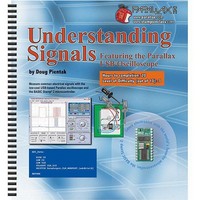70009 Parallax Inc, 70009 Datasheet - Page 11

70009
Manufacturer Part Number
70009
Description
BOOK UNDERSTANDING SIGNALS
Manufacturer
Parallax Inc
Type
Signal Analysisr
Datasheet
1.70009.pdf
(137 pages)
Specifications of 70009
Style
Book
Title
Understanding Signals
Contents
Guide to Generate, View and Measure Wave Forms
Product
Microcontroller Accessories
Lead Free Status / RoHS Status
Not applicable / Not applicable
Other names
70009PAR
Available stocks
Company
Part Number
Manufacturer
Quantity
Price
Company:
Part Number:
700090B
Manufacturer:
COPAL
Quantity:
5 510
Company:
Part Number:
70009CB
Manufacturer:
VISHAY
Quantity:
5 510
Part Number:
70009GB
Manufacturer:
TI/PHILIPS
Quantity:
20 000
Chapter 1: Oscilloscope Basics · Page 3
The trigger controls when the oscilloscope will start recording the input signal. The
trigger allows you to capture and view only the segment in which you are interested. The
criteria controlling the trigger action is called a trigger event. The OPTAscope 81M has
edge-triggered events. More advanced oscilloscopes have several types of configurable
trigger events: pulse width events, pulse sequence events, and even more exotic event
triggers that can trigger on the start of a video packet in a composite TV signal. This text
will focus on the OPTAscope’s edge-trigger event ability.
There are two types of trigger events supported by the OPTAscope: rising edge, and
falling edge. A rising edge is described as the point at which a relatively low voltage
signal ascends to a relatively higher voltage. The converse is a falling edge. A rising edge
trigger event will occur when the voltage of the signal rises above the set trigger point,
and a falling edge trigger event occurs when the voltage falls below the trigger point.
Upon a valid trigger event, the OPTAscope will begin recording the sampled signal input
and continue until its memory is full.
When the OPTAscope displays the captured signal, the trigger event will be centered in
the display for you to see. A rising edge-triggered signal is depicted in Figure 1-3.
Anything to the left of the trigger event is called “pre-trigger” because it happens before
the trigger event. Anything to the right of the trigger event is called “post trigger”. This is
important because when attempting to trigger the oscilloscope to capture a specific event,
you need to set your trigger level to get as close as possible to the event you want to see.
In Figure 1-3, only one signal is displayed on the screen. With OPTAscope 81M you can
have two signals displayed on the screen at the same time. Both signals are sampled or
recorded concurrently, which allows you to view both signals (called channels) during
the same period of time.
During the exercises in this text, you will use the OPTAscope to trigger, capture, and
display signals. In doing so, you will learn the function and use of oscilloscopes, and gain
a greater understanding of the different signal types you will encounter. Ultimately, you
will also see how these skills can be useful working with different electronics
applications.



















